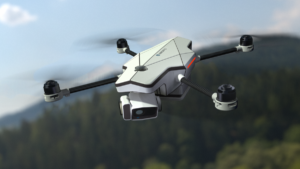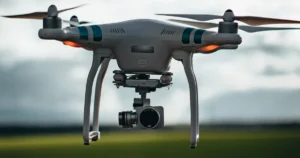Development of Autonomous Drones
The development of autonomous drones has been an exciting and fast-moving field in recent years. Autonomous drones, also known as unmanned aerial vehicles (UAVs), are aircraft that can fly and operate without a human pilot. They have become increasingly popular for their potential in a variety of industries, including military, commercial, and civilian applications.
Autonomous drones were first developed in the military industry, primarily for surveillance and reconnaissance purposes. The United States military began experimenting with drone technology in the 1950s, but it wasn’t until the 1990s that unmanned aircraft became more widespread. During the Gulf War, the military deployed unmanned aircraft to gather intelligence and conduct reconnaissance missions.

As the technology improved, autonomous drones began to be used for more complex missions. In the early 2000s, the U.S. military began using drones for targeted strikes in Afghanistan and Iraq. This marked a major shift in the use of autonomous drones, as they were no longer simply used for surveillance but were also used for offensive purposes.
The use of autonomous drones for commercial purposes began to develop in the early 2010s. Companies began using drones for tasks such as surveying land, inspecting pipelines, and delivering packages. Amazon was one of the first companies to announce its intention to use drones for package delivery in 2013, and since then, other companies, including Google and UPS, have followed suit.
The development of autonomous drone technology has been driven by advancements in a variety of fields, including computer science, robotics, and engineering. One of the key challenges in developing autonomous drones is creating a system that can safely and effectively navigate and operate without human intervention.
To achieve this, drones are equipped with a variety of sensors, including cameras, GPS, and lidar (light detection and ranging) systems. These sensors allow drones to detect obstacles, measure distances, and maintain their position and orientation in space. Drones also use sophisticated algorithms and software to process the data from these sensors and make decisions about their flight paths and actions.
Another challenge in developing autonomous drones is ensuring that they can communicate effectively with other drones and with ground-based systems. This is particularly important in commercial applications, where drones may be operating in crowded airspace alongside other aircraft.
To address this challenge, researchers have developed a variety of communication protocols and systems that allow drones to communicate with each other and with ground-based systems. These systems can help drones avoid collisions, coordinate their movements, and share information about their surroundings.
The development of autonomous drones has also raised important ethical and legal questions. For example, there are concerns about privacy violations and the potential for drones to be used for surveillance or other nefarious purposes. There are also questions about liability and responsibility in the event of accidents or other incidents involving autonomous drones.
To address these issues, governments and regulatory bodies around the world have developed guidelines and regulations for the use of autonomous drones. In the United States, the Federal Aviation Administration (FAA) has developed guidelines for the commercial use of drones, including requirements for registration and certification.
Despite the challenges and controversies surrounding autonomous drones, their development shows no signs of slowing down. As technology continues to advance and new applications for autonomous drones are discovered, they are likely to become an increasingly common sight in our skies. From delivering packages to monitoring crops to conducting search and rescue missions, the potential uses for autonomous drones are vast and varied. The only limit is our imagination.

As the technology continues to develop, autonomous drones will likely play an increasingly important role in disaster response and search and rescue operations. With their ability to quickly and efficiently search large areas and navigate challenging terrain, autonomous drones can help to save lives in emergency situations.
The development of autonomous drones also has the potential to revolutionize transportation and logistics. Companies such as Amazon and UPS are already exploring the use of drones for package delivery, and it’s not difficult to imagine a future where autonomous drones are used for everything from transporting people to delivering groceries.
While the potential benefits of autonomous drones are clear, there are also significant challenges that need to be addressed. One of the biggest challenges is ensuring that drones can operate safely and effectively in crowded airspace. As more drones take to the skies, there is a risk of collisions and other accidents, particularly in urban areas.
To address this challenge, researchers are developing new technologies such as sense and avoid systems and advanced communication protocols that allow drones to navigate safely and effectively in crowded airspace. Governments and regulatory bodies are also developing guidelines and regulations to ensure that drones are operated safely and responsibly.
Another challenge is ensuring that autonomous drones are secure from hacking and other cyber threats. As drones become increasingly connected and autonomous, they become potential targets for cyberattacks, which could compromise their ability to operate safely and effectively.
To address this challenge, researchers are developing new technologies to protect drones from cyber threats, including encryption and secure communication protocols. Companies and governments are also investing in cybersecurity research and development to ensure that drones are secure and reliable.
In the construction industry, drones can be used for site inspections and monitoring, providing real-time data and helping to improve safety and efficiency. In the energy sector, drones can be used to inspect pipelines and power lines, reducing the need for costly and dangerous manual inspections.
In conclusion, the development of autonomous drones has been an exciting and rapidly evolving field in recent years. Autonomous drones have the potential to transform a wide range of industries, from military to commercial to civilian applications. While there are challenges and controversies surrounding their development, the potential benefits of autonomous drones are too significant to ignore.
As technology continues to advance, we can expect to see increasingly sophisticated and capable autonomous drones taking on more complex missions and expanding the possibilities of what is possible with this technology. The development of autonomous drones has already made a significant impact in fields such as agriculture, where drones can be used to monitor crops and detect disease or pests, allowing for more efficient and targeted use of pesticides and fertilizers.











